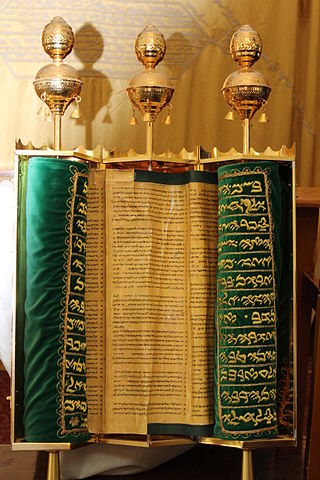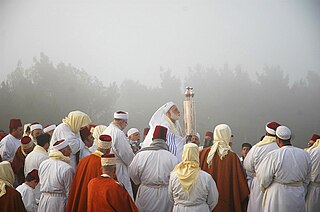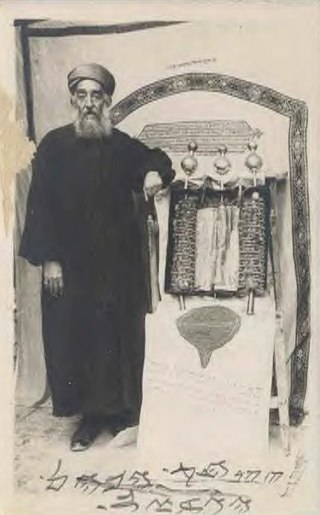
According to Abrahamic religions, Aaron was a Jewish prophet, a high priest, and the elder brother of Moses. Information about Aaron comes exclusively from religious texts, such as the Hebrew Bible, the New Testament, and the Quran.

Samaritanism is an Abrahamic monotheistic ethnic religion. It comprises the collective spiritual, cultural, and legal traditions of the Samaritan people, who originate from the Hebrews and Israelites and began to emerge as a relatively distinct group after the Kingdom of Israel was conquered by the Neo-Assyrian Empire during the Iron Age. Central to the faith is the Samaritan Pentateuch, which Samaritans believe is the original and unchanged version of the Torah.

The Samaritans, often preferring to be called Israelite Samaritans, are an ethnoreligious group originating from the Hebrews and Israelites of the ancient Near East. They are indigenous to Samaria, a historical region of ancient Israel and Judah that comprises the northern half of what is today referred to as the West Bank. They are adherents of Samaritanism, an Abrahamic, monotheistic, and ethnic religion that developed alongside Judaism.

The Israelites were a Hebrew-speaking ethnoreligious group consisting of tribes that inhabited much of Canaan during the Iron Age.
Uzzi is a given name. One derivation is biblical, from Uzzî meaning "my strength". The name can also be transliterated as Uzi. It may be a nickname for Uzza/Uzzah, Uzzia/Uzziah, and Uziel/Uzziel.

The Samaritan Pentateuch, also called the Samaritan Torah, is the sacred scripture of the Samaritans. Written in the Samaritan script, it dates back to one of the ancient versions of the Torah that existed during the Second Temple period. It constitutes the entire biblical canon in Samaritanism.

The parable of the Good Samaritan is told by Jesus in the Gospel of Luke. It is about a traveler who is stripped of clothing, beaten, and left half dead alongside the road. A Jewish priest and then a Levite come by, both avoiding the man. A Samaritan happens upon him and, though Samaritans and Jews were generally antagonistic toward each other, helps him. Jesus tells the parable in response to a provocative question from a lawyer in the context of the Great Commandment: "And who is my neighbor?" The conclusion is that the neighbor figure in the parable is the one who shows mercy to their fellow man or woman.

Mount Gerizim is one of two mountains in the immediate vicinity of the Palestinian city of Nablus and the biblical city of Shechem. It forms the southern side of the valley in which Nablus is situated, the northern side being formed by Mount Ebal. The mountain is one of the highest peaks in the West Bank and rises to 881 m (2,890 ft) above sea level, 70 m (230 ft) lower than Mount Ebal. The mountain is particularly steep on the northern side, is sparsely covered at the top with shrubbery, and lower down there is a spring with a high yield of fresh water. For the Samaritan people, most of whom live around it, Mount Gerizim is considered the holiest place on Earth.

Moses Gaster was a Romanian, later British scholar, the Hakham of the Spanish and Portuguese Jewish congregation, London, and a Hebrew and Romanian linguist. Moses Gaster was an active Zionist in Romania as well as in England, where in 1899 he helped establish the English Zionist Federation.
The Book of Joshua, sometimes called the Samaritan Chronicle, is a Samaritan chronicle so called because the greater part of it is devoted to the history of Joshua. It is extant in two divergent recensions, one in Samaritan Hebrew and the other in Arabic.

The Samaritan High Priest is the High Priest of the Samaritan community in the Holy Land, who call themselves the Israelite Samaritans. According to Samaritan tradition, the office has existed continuously since the time of Aaron, the brother of Moses, and has been held by 133 priests over the last 3400 years. However, the historicity of this claim is disputed. One account by Josephus suggests that its office holders are an offshoot of the Zadokite high priests of Jerusalem from around the time of Alexander the Great. As of 2024, the incumbent High Priest is Abdel V.
Bukki may have been an early High Priest of Israel. Another Bukki is mentioned in Numbers as a leader in the Tribe of Dan.
The Asaṭīr, also known as the Samaritan Book of the Secrets of Moses, is a collection of Samaritan Biblical legends, parallel to the Jewish Midrash, and which draws heavily upon oral traditions known among Jews in the 2nd and 3rd centuries CE. Moses Gaster places its compilation about the middle or end of the third century BCE, and rendered a translation of the work in 1927 with the Royal Asiatic Society in London. Others have said that its language style resembles more the Arabic language used by the scholar Ab Ḥisda [Isda] of Tyre in his poems of the eleventh century CE, and place its composition in the second-half of the tenth-century. The book's title, Asatir, was thought by Gaster to mean "secrets," from which name, he applied to the book its newer title, "The Secrets of Moses." Even so, such an interpretation has nothing to do with the contents of the book, nor with its subject. A more precise translation of the Arabic title of the work, al-Asāṭīr, would be "legends" or "tales," as in the Koranic expression asāṭīr al-Awwalīn.

Amram IX ben Yitzhaq ben Amram ben Shalma was the 124th Samaritan High Priest from 1961–1980. He came from the house of Yitzhaq, descendants of Yitzhaq ben Amram ben Shalma. He was the father of Saloum Cohen.

Abisha III ben Phinhas ben Yitzhaq ben Shalma was the 123rd Samaritan High Priest from 1943 to 1961. He is a member of the house of Pinhas, descendants of Pinhas ben Yitzhaq ben Shalma, and brother of the previous high priest Matzliach ben Phinhas ben Yitzhaq ben Shalma.

Yitzhaq II ben Amram ben Shalma ben Tabia was the 121st Samaritan High Priest from 1916–1932. He is the progenitor of the house of Yitzhaq, one of the three houses of Samaritan High Priests.
Matzliach ben Phinhas ben Yitzhaq ben Shalma was the 122nd Samaritan High Priest from 1933 to 1943. He was succeeded by his brother Abisha III ben Phinhas ben Yitzhaq ben Shalma, both of them being members of the clan of Phinhas, descendants of Phinhas ben Yitzhaq ben Shalma. His sons Asher ben Matzliach ben Phinehas and Phinehas X ben Matzliach ben Phinehas would later become high priests. His grandson became high priest Aabed-El ben Asher ben Matzliach.
Asher ben Matzliach ben Phinhas was the 125th Samaritan High Priest from 1980 to 1982. He was the son of Matzliach ben Phinhas ben Yitzhaq ben Shalma, and the nephew of Abisha III ben Phinhas ben Yittzhaq ben Shalma. In 1982 he was succeeded by his brother Phinehas X ben Matzliach ben Phinehas. His son became high priest Aabed-El ben Asher ben Matzliach.
Phinehas X ben Matzliach ben Phinehas was the 126th Samaritan High Priest from 1982 to 1984. He was the son of Matzliach ben Phinhas ben Yitzhaq ben Shalma and the nephew of Abisha III ben Phinhas ben Yittzhaq ben Shalma. He succeeded his brother Asher ben Matzliach ben Phinehas as high priest and was succeeded by Yaacob II ben Uzzi ben Yaacob ben Aaharon in 1984. His nephew became high priest Aabed-El ben Asher ben Matzliach.











